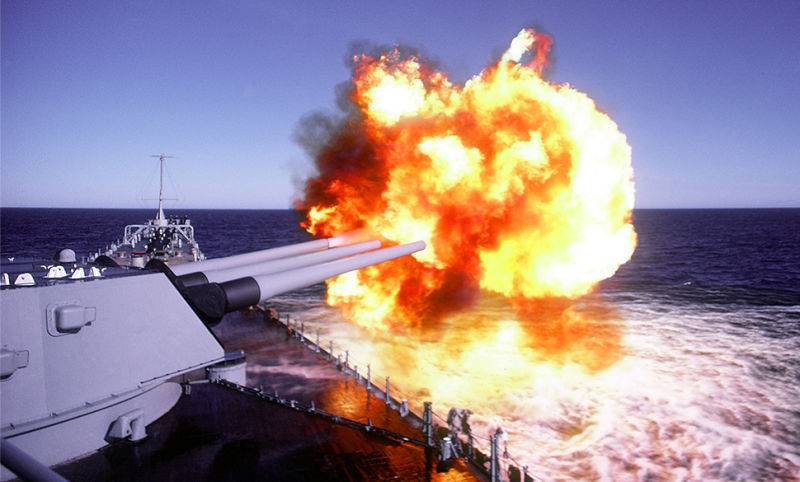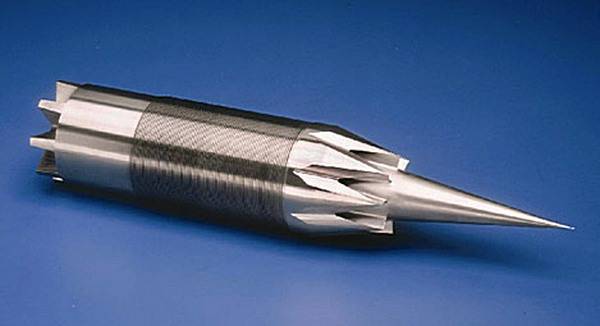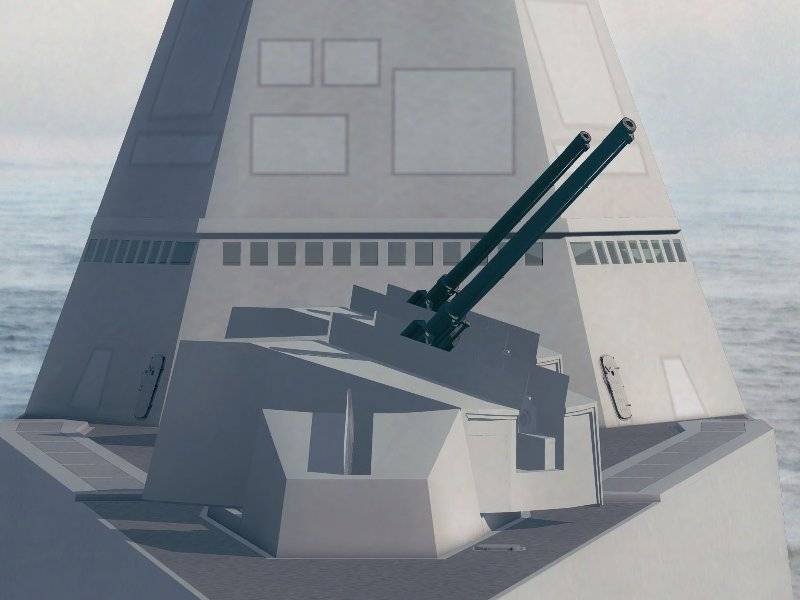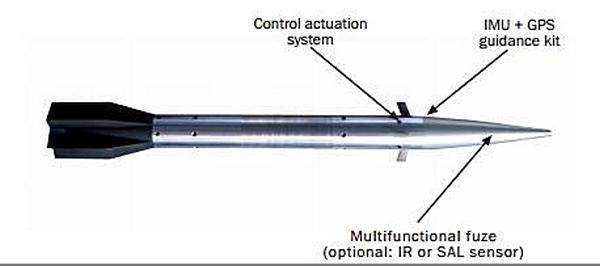The return of big guns. Isn't the bet on anti-ship missiles wrong?

Then there was the Indo-Pakistani war 1971 of the year, where Indians with the same missiles, not really straining, caused great damage to Pakistan, using Termites against both surface and ground-based heat and radio contrast objects.
In NATO, where naval superiority over the USSR, on the one hand, was considered very important, and on the other, almost guaranteed, sounded the alarm. Already in the early seventies, several anti-ship missiles began to be developed, which later became de facto symbols of the Western fleets. So, in 1971-m started the development of such missiles as the American RCC "Harpoon", and the French "Exochet". Both were later used in hostilities, but they were not the only examples.
NATO’s surprise was all the more intense because during the Second World War, the Allies had already suffered losses from high-precision anti-ship weapons, and even developed effective protective measures - targeting interferences that interfere with the work of the radio command of German guided bombs.
In the Soviet Union, the development programs of RCC developed simply to unprecedented heights. Given the enemy’s presence of a powerful aircraft carrier fleet and the lack of such in its navy, the USSR found a way out in long-range and high-speed missiles with a powerful warhead, in some cases a nuclear one.
The speeds of the rockets grew, first overcoming one “sound”, then two. Improved homing systems, software algorithms, increased the size and distance of the flight ...
In principle, the apogee of those works can be observed today on board the cruisers of the 1164 project, where huge PUs for the PKR occupy a significant part of the ship.
However, in the combat use of anti-ship missiles there has been a certain turn.
In the 1973 year, during the next Arab-Israeli war, both the Syrians and the Egyptians, trying to use the P-15 anti-ship missiles against Israeli boats, suffered severe losses and suffered casualties without causing any harm to the Israelis. The latter, in addition to the vicious tactics of the Arabs, succeeded, using EW complexes, to “take away” all the missiles aimed at them.
But then we see one curious detail - the Israelis widely used not only anti-ship missiles, but also 76-mm guns. Moreover, the Arabs had no answer to that - their missile boats did not have comparable weapons, and could not fight after the exhaustion of the missiles.
It was a new trend. Rockets, as it turned out, you can simply lead to the side. And the guns, as it also turned out, are quite significant weapons even in the nuclear-missile era.
Let us venture to suggest that those two battles won by the Israelis "dry" became a kind of turning point.
It was after them that the whole world rushed to improve the system of jamming. And it was after them in the USSR that they again began to “invest” in the development of naval artillery, caliber over 76 mm, which had been stopped under Khrushchev’s directives.
Further events of the world military stories were very revealing.
In 1980, during Operation Pearl, the Iranians melted the entire nearly Iraqi fleet using the Harpoon anti-ship missiles and aviation UR "Mayverik". The parties did not apply interference and had losses in the ship's composition (however, interference against Iranian aviation, apparently, would not have worked).
In the 1982 year, during the Falklands conflict, the Argentine Exoset missiles could not hit ships that were covered with interference, but hit those that were not protected. Both during the destruction of Sheffield and during the defeat of the Atlantic Conveyor, it was confirmed that EW and jamming complexes are reliable protection against anti-ship missiles, but non-interference means the death of the ship.
In 1986, during a battle in the Gulf of Sidra, the Americans destroyed a Libyan boat and a small Soviet-built rocket ship using the Harpoon missiles launched from the Yorktown cruiser and the A-6 deck attack aircraft. Libyans did not apply interference. Another specific phenomenon in this battle was the use of anti-ship missiles at distances substantially smaller than the maximum.
In 1987, the Iranians seriously damaged the American frigate Stark by two anti-ship missiles Exocet launched from a Mirage aircraft. The frigate did not use interference complexes.
In the 1988 year, during the American operation Mantis against Iranian forces in the Persian Gulf, both Iranians and Americans used anti-ship missiles against each other’s surface ships. The fact of using missiles at a distance less than the maximum was repeated All Iranian attacks against American destroyers were neutralized using jamming systems. The Iranians did not have those on their ships, and suffered losses from American missiles. Massive use against SM-1 anti-aircraft missiles has become new. These missiles proved to be more effective than anti-ship missiles at short distances typical of the Persian Gulf. It was again confirmed that it was almost impossible to hit a ship covered with interference with PKR. It is an amusing way to repeat the Anglo-Americans fight with German guided bombs during the Second World War.
Later, the Americans generally abandon the installation of the RCC "Harpoon" on the newly built ships, "laying" the task of defeating surface targets on anti-aircraft missiles.
In the 2008 year, during the conflict in South Ossetia, the IRC Mirage of the Black Sea Fleet of Russia allegedly destroyed one Georgian boat using anti-ship and anti-aircraft missiles. Georgians did not have EW complexes.
Let us outline clearly emerging trends. Here they are:
- Anti-ship missiles are almost always effectively neutralized by jamming systems; But in the absence of such, missile attacks are deadly.
- Anti-ship missiles are used at much shorter ranges than the theoretical maximum ones. The typical distance is measured in tens of kilometers.
- Anti-aircraft missiles are often more effective means of dealing with ships than anti-ship missiles.
Moreover, the analysis of both the fighting in the Persian Gulf and the exercises there led the Americans to a paradoxical conclusion at first glance, namely: “Before an attack performed in the intensive shipping zone, the target must be identified visually.”
If the conclusion about interference is self-evident, then the following should be disassembled in more detail.
The specific nature of the anti-ship missile is that the target can be captured by its homing head (GOS) in different ways. Aviation missiles in theory can capture a target either on a carrier or on a course. But capturing a target on a carrier requires flying at a high altitude, or launching from a short distance. Flying at high altitude is fraught with an unpleasant encounter with an anti-aircraft missile, respectively, when an air-based anti-aircraft missile is struck, it is necessary to attack the target from not only from a low altitude, but also from a short distance. Hence the need to carry out the so-called "Breakthrough to the goal."
When using anti-ship missiles with a homing system, which is exciting the target on the course, that is, after the launch, there is another problem - when shooting at long distances, the target can go beyond the scope of the missile’s seeker’s sector. This again requires a reduction in the launch distance.
Naturally, the options for capturing the target on the carrier can be considered practically only in relation to aircraft missiles, it is not rational to have such weapons on ships, and for a shipboard anti-ship missile target seizure on the course is practically the only option.
From all of the above, you can make a simple conclusion - when shooting at long distances, the rocket needs continuous target designation. Or - to reduce the distance. Providing continuous target designation is difficult, even when the enemy does not apply any countermeasures, and it is often impossible.
And, of course, the problem is the inability of the missile to identify the target. “Hooking” its GOS to the first radio-contrast target, the rocket will go only to her, she will not be able to distinguish a cruise liner or a tanker under a neutral flag from an enemy warship. And this is already fraught with political complications, even involving the "neutrals" in the war on the side of the enemy, which is apparently unacceptable.
A kind of exception to this is the huge Soviet supersonic P-500 "Basalt", P-700 "Granit" and P-1000 "Vulkan" missiles, which have radar stations, their own jamming stations, and sophisticated target attack algorithms, including, presumably, recognition algorithms. But - trouble - they are huge and monstrously expensive, in addition, a modern combat ship working from such a rocket will detect from a great distance, and the rocket itself has a considerable EPR. Moreover, when flying at low altitudes, due to the Prandtl-Gloert effect, a huge high-speed rocket collects a real water reflector from the air, which increases its EPR and visibility in the radar range by several times, compared to small subsonic missiles (however, they have this effect is also present, just expressed significantly less).
Such missiles are in some sense a dead end - a modern warship can still detect and shoot them down, and it is a pity to spend them on a little less modern just because of the huge price. Yes, and tactical applicability of the size limit. So, in order to “break through” air defense warrants from ships equipped with the AEGIS system, a volley of dozens of such missiles will be required. And this means that, for example, the Pacific Fleet will have to “discharge” almost all of its ammunition in the direction of the enemy, which will put further participation of ships and strike submarines in combat operations “in question”. The fact that such missiles do not have a future is understood by the Navy, and it is not for nothing that the modernization of the nuclear submarine of the 949 project and the Admiral Nakhimov TAVKR implies their replacement with another weapon.
Another exception is the latest American anti-ship missile LRASM. Unlike the Soviet monsters, this rocket is much less noticeable in the radar range, and its “intelligence” is disproportionately higher. So, during the tests, the missiles coped with autonomous laying of the course to the attacked targets without the reference points laid down in the on-board computer beforehand, that is, the rocket independently planned a combat operation during the flight and carried it out. The rocket "incorporated" the ability to independently search for a target in the intended area of its location, high maneuverability, the ability to recognize designated targets, the ability for long-term low-altitude flight, the ability to evade sources of radar radiation, the ability to receive data in flight and a huge range, up to 930 kilometers.
All this makes it an extremely dangerous weapon. At present, there are practically no ships in the Russian Navy capable of repelling such a missile attack, perhaps this is due to the new frigates of the 22350 project, provided that the Poliment-Redut air defense system has reached the required level of combat readiness and the required level of training. But even in this case, the frigates are not enough, because their series with a high degree of probability, will be limited to four ships. The Americans are already re-equipping the 28-e wing of the strategic aviation command of the Air Force on these missiles, in any case, the crews of the B-1B Lancer aircraft, which will use this weapon, have been training on simulators since this summer. Americans, thus, create at their place an analogue of the Soviet Sea-based missile-carrying aircraft, only in the Air Force system.
However, like any super weapon LRASM has a flaw - the price.
The first 23 pre-production rockets cost the Pentagon 86,5 million dollars, 3,76 million dollars for a rocket. The second lot - 50 serial missiles, will cost 172 million dollars, or about 3,44 million per rocket. At the same time, back in 2016, it was expected that the price of one rocket would be about 3 million dollars.
It is not difficult to guess that such missiles cannot be fired at any detected target. Yes, and "Harpoons" now went up - 1,2 million dollars for "Block II".
Well, and again, it is worth understanding that a reception will be found on this scrap, as part of the eternal competition of the sword and shield.
Thus, while PR leaders of defense companies lead the public in admiration of the parameters of new missiles, in practice the combination of EW efficiency, passive jamming, air defense of ships, and economic realities (RCC are expensive) leads to the fact that the use of these weapons in some cases simply turns out to be doubtful.
This is especially clear if you ignore the huge cruisers and destroyers, and look at light frigates and corvettes, which are the main types of warships in the world - few ships in the arsenal of more than eight anti-ship missiles. Even if we discard all those problems that in reality accompany their use, and assume that each rocket hits the target, then what to do after they are used up? During the exercises of the Baltic Fleet, the 20380 project corvettes moored overboard to the floating crane, and they were replaced with transport and launch containers right at sea. But a little further from the coast, this is no longer done, and indeed, it’s not a fact that it will work out in a combat situation. And of course, restrictions on the range of use of missiles, target designation, and non-selectivity of action for small ships with light missiles (the same UPR) operate in a much more “acute” form - they are simply insurmountable.
All of the above leads us to a simple conclusion - since rockets generally do not fly more than a few tens of kilometers (apart from the maximum flight range achieved in tests), since they are knocked down and diverted by means of EW and interference, since they create a tremendous risk of neutralization goals, sometimes with huge human sacrifices, then ... it is worth doing without them! Just as the relatively new destroyers of the US Navy, have no RCCs at all.
This conclusion is rather difficult to accept, but it may be so.
In fact, this does not mean that you need to take and abandon missiles. Still, they allow you to “start a fight” at a very decent distance, with a massive launch on one target, the EW system will most likely not be able to divert the volley, the passive jamming complexes have limited ammunition, and, in general, it is quite possible to sink even modern warships, if tactics and volley density at the right level. But it is not a panacea, and not a super-weapon. And it will often fail. Sometimes it will simply be impossible to apply. To this must be prepared.
What, then, should be the main means of fire with which some ships can fight with others?
The US Navy is now anti-aircraft missiles, and in other fleets do not think about it, relying on RCC.
We venture to suggest that in the future it will be guns. Like before.
At present, naval specialists in most countries are confident that the range of calibers 57-130 mm completely covers the needs of fleets in ship artillery. Almost everywhere, ideas about the revival of large (at least 152 mm) calibers, meet with sharp rejection.
Nevertheless, think a little.
During the battles for Quito-Kanavale in 1988, Soviet military advisers paid attention to new South African shells - when they fell on the target, they glowed in the dark and were visually observable. At the same time, the distance from which South African troops fired on Angolans and their Soviet instructors exceeded 50 kilometers, and the accuracy of hits in principle did not differ from conventional artillery systems.
A little later, it became known that the South Africans used active-rocket projectiles against Angola, which were fired from conventional howitzers with 155-mm caliber. Creation of the tragic artillery genius Gerald Bulle, these shells have shown that an ordinary, not modernized gun can easily reach a firing range comparable to rocket weapons, if you use special ammunition.
Another interesting historical example is the reactivation of American battleships in the 80s. Their guns had a chance to shoot in a combat situation only at ground targets, from which many military history enthusiasts concluded that they were returned to the system in order to shoot at the shore.
In practice, the battleships were intensively trained in firing from cannons specifically for naval targets, and in the event of war with the USSR, it was intended to form naval strike groups around them that would act against the Soviet Navy in areas with a low level of air threat, for example, in the Indian Ocean. Moreover, there were projects to create 406-mm active-rocket projectiles with direct-flow-air engines, which, in the fall on the target would reach hypersonic speed. The authors of the projects were confident that the range of 406-mm guns with such ammunition will reach approximately 400 kilometers. The Navy, however, did not invest in obsolete ships.

It is worth noting that the old Soviet light cruisers of the 68-bis project, when carrying out tasks of directly tracking US and NATO ship groups, were perceived by the latter for a very long time as an extremely serious threat. A cruiser, for all its obsolescence, would do nothing to open heavy fire on an aircraft carrier, making flights from its deck impossible, and then, before drowning, to inflict huge losses on light escort destroyers. The guns when performing such a task were simply incomparably more effective than any type of missile, especially if you remember about several towers capable of firing at several targets simultaneously. The same British, whose ships were much more "flimsy" than the Americans, considered the cruisers 68-bis as a very serious threat, in fact, they were such a threat. It is also worth noting that the caliber 152-mm already allowed in theory the use of nuclear ammunition, have any in stock, and the ship be equipped with the appropriate way. This makes a completely different look at the potential of the Soviet light cruisers. However, now it is no longer relevant.
The first attempt to return the big guns to the ship in the modern era is the construction program for the Zumvalt class destroyers. From the very beginning of one of the tasks, these huge ships had fire support of an amphibious landing, for which they received two ultramodern 155-mm guns.

The American military industrial complex nevertheless played a cruel joke with the Navy, driving the cost of projectiles for the new system into a seven-digit figure, which deprived the idea of meaning. Nevertheless, it is worth mentioning that the Zumvalt gun quite successfully fired at 109 kilometers, which exceeds the range of use of the Harpoon achieved in real battles by a factor of three. The gun fired, however, at the ground target, but if it were a homing anti-ship projectile, it would not hurt anything to shoot at the surface. Projectiles, thus, reached a completely "missile" range.
Make a bold assumption.
Even if an artillery shell costs a million dollars, like a projectile for a Zumwalt AGS, it is still more profitable than anti-ship missiles, and here's why.
RCC is detected using radar in advance, and makes it possible to resort to means of electronic warfare and passive interference. The projectile flies much faster, and leaves little time for reaction. Most modern ships are not able to detect artillery shells, and certainly can not bring it down. And the most important thing is that the crew understands that they are shooting at their ship only after the first explosion - and the same passive interference can simply not be in time, because you need to know that a rocket or projectile is coming at you! And with a projectile is impossible. Now at least. Well, the speed of the projectile is such that the ship from the ejected cloud of passive interference simply does not have time to leave, the projectile will be no matter what to look for, it will still get into the ship too.
RCC on the ship can not be much. The exception is super-expensive LRASM on cruisers and destroyers with UVP, but there and the order of prices per shot is a completely different one. Shells on the ship can be hundreds, at least dozens.
Placing the CRP in large quantities makes the ship large. Artillery ship much more compact.
The rocket ship needs complex and very expensive upgrades. The artillery ship needs to load new shells into the cellar and no more.
And if you make a shell three times cheaper? At five?
In fact, if you think carefully, it turns out that guided and self-guided projectiles are a far more promising thing than the continuous and extremely expensive development of large, heavy and expensive guided missiles. Rockets, as already mentioned, will not cancel, but here they will squeeze their niche.
And it seems that in the West this is realized.
Relatively recently, a consortium of BAE Systems and Leonardo introduced to the market a family of ammunition for 76-127 mm caliber naval guns, and 155-mm ground howitzers. This is a family of ammunition. Volcano.
Consider, for example, only one of the ammunition in the family - the sea 127-mm projectile. Like everyone else, it is subcaliber, with improved aerodynamics. Due to aerodynamics, its flight range is 90 kilometers. The trajectory correction is made according to satellite and inertial navigation systems. And in the final segment, the projectile searches for a target using an infrared homing system.

This is still an imperfect solution, it is not universal and has a number of conceptual flaws. However, such a projectile in any case significantly increases the combat potential of any ship to which it is loaded. And most importantly, this is a truly massive decision; for the use of these ammunition, ships practically do not need any refinement. This is the beginning of the artillery renaissance.
Technologies that allow “for cheap” to pack in a projectile homing system, and in a larger projectile - a jet engine, no doubt, will change the nature of the battles at sea. After all, the caliber of 127 millimeters allows you to make a decent active-rocket projectile in the future, which means the gun will become a launcher, and the projectiles will merge with missiles in their development, only shells on board can be taken more than missiles and their replenishment at sea is no problem.
When creating new ships, it is possible to “rebalance” the ship’s weapon systems — instead of a multitude of anti-ship missile launchers, which take up a lot of space and require an increase in displacement, you can simply load more guided or self-guided projectiles into the ship, increasing the artillery cellars, and quantity, or use for something else, such as anti-aircraft missiles or anti-submarine weapons. In the alternative - to reduce the size of the ships, making them cheaper and more massive, more subtle.
Such innovations could be very appropriate for a country that will soon have to recreate its fleet again. For a country that has excellent guns with a caliber of 130 millimeters, and generally a great artillery gun making school. And if in the caliber 130 mm you can create a long-range self-guided projectile, then, when approaching the caliber 200 millimeters, you can create an already active-reactive with a powerful warhead. And to achieve decisive advantages in any kind of battle, except the battle with aviation. Moreover, it is not very expensive compared to the creation of purely rocket monster ships.
Probably, it is not necessary to say that Russia will sleep through all these opportunities again.
But it will be very interesting to watch the beginning artillery renaissance at least from the outside. Naturally, while all these innovations do not hit us.
Information